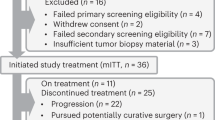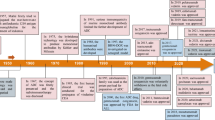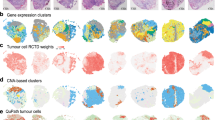Abstract
In the continuing search for effective treatments for cancer, the emerging model is the combination of traditional chemotherapy with anti-angiogenesis agents1 that inhibit blood vessel growth. However, the implementation of this strategy has faced two major obstacles. First, the long-term shutdown of tumour blood vessels by the anti-angiogenesis agent can prevent the tumour from receiving a therapeutic concentration of the chemotherapy agent. Second, inhibiting blood supply drives the intra-tumoural accumulation of hypoxia-inducible factor-1α (HIF1-α); overexpression of HIF1-α is correlated with increased tumour invasiveness and resistance to chemotherapy2,3,4,5. Here we report the disease-driven engineering of a drug delivery system, a ‘nanocell’, which overcomes these barriers unique to solid tumours. The nanocell comprises a nuclear nanoparticle within an extranuclear pegylated-lipid envelope, and is preferentially taken up by the tumour. The nanocell enables a temporal release of two drugs: the outer envelope first releases an anti-angiogenesis agent, causing a vascular shutdown; the inner nanoparticle, which is trapped inside the tumour, then releases a chemotherapy agent. This focal release within a tumour results in improved therapeutic index with reduced toxicity. The technology can be extended to additional agents, so as to target multiple signalling pathways or distinct tumour compartments, enabling the model of an ‘integrative’ approach in cancer therapy.
This is a preview of subscription content, access via your institution
Access options
Subscribe to this journal
Receive 51 print issues and online access
$199.00 per year
only $3.90 per issue
Buy this article
- Purchase on Springer Link
- Instant access to full article PDF
Prices may be subject to local taxes which are calculated during checkout




Similar content being viewed by others
References
Kerbel, R. S. & Kamen, B. A. The anti-angiogenic basis of metronomic chemotherapy. Nature Rev. Cancer 4, 423–436 (2004)
Semenza, G. L. Surviving ischemia: adaptive responses mediated by hypoxia-inducible factor 1. J. Clin. Invest. 106, 809–812 (2000)
Tran, J. et al. A role for survivin in chemoresistance of endothelial cells mediated by VEGF. Proc. Natl Acad. Sci. USA 99, 4349–4354 (2002)
Yu, J. L., Rak, J. W., Coomber, B. L., Hicklin, D. J. & Kerbel, R. S. Effect of p53 status on tumour response to antiangiogenic therapy. Science 295, 1526–1528 (2002)
Blagosklonny, M. V. Antiangiogenic therapy and tumour progression. Cancer Cell 5, 13–17 (2004)
Pennacchietti, S. et al. Hypoxia promotes invasive growth by transcriptional activation of the met protooncogene. Cancer Cell 3, 347–361 (2003)
Rofstad, E. K. et al. Hypoxia promotes lymph node metastasis in human melanoma xenografts by up-regulating the urokinase-type plasminogen activator receptor. Cancer Res. 62, 1847–1853 (2002)
Kieran, M. W., Folkman, J. & Heymach, J. Angiogenesis inhibitors and hypoxia. Nature Med. 9, 1104 (2003)
Kerbel, R. & Folkman, J. Clinical translation of angiogenesis inhibitors. Nature Rev. Cancer 2, 727–739 (2002)
Chabner, B. A., et al. Goodman and Gilman's The Pharmacological Basis of Therapeutics 9th edn (McGraw-Hill, 1996)
Tozer, G. M., Kanthou, C., Parkins, C. S. & Hill, S. A. The biology of the combretastatins as tumour vascular targeting agents. Int. J. Exp. Pathol. 83, 21–38 (2002)
Miklos, A. G., Lyman, M. D., Freed, L. E. & Langer, R. Wetting of poly(l-lactic acid) and poly(d-lactic-co-glycolic acid) foams for tissue culture. Biomaterials 15, 55–58 (1994)
Yoo, H. S., Oh, J. E., Lee, K. H. & Park, T. G. Biodegradable nanoparticles containing doxorubicin-PLGA conjugate for sustained release. Pharm. Res. 16, 1114–1118 (1999)
Sengupta, S., Kiziltepe, T. & Sasisekharan, R. A dual-colour fluorescence imaging-based system for the dissection of antiangiogenic and chemotherapeutic activity of molecules. FASEB J. 18, 1565–1567 (2004)
Jain, R. K. Normalizing tumour vasculature with anti-angiogenic therapy: a new paradigm for combination therapy. Nature Med. 7, 987–989 (2001)
Hanahan, D., Bergers, G. & Bergsland, E. Less is more, regularly: metronomic dosing of cytotoxic drugs can target tumour angiogenesis in mice. J. Clin. Invest. 105, 1045–1047 (2000)
Allen, T. M. Ligand-targeted therapeutics in anticancer therapy. Nature Rev. Drug Discov. 2, 750–763 (2002)
Yuan, F. et al. Vascular permeability in a human tumour xenograft: molecular size dependence and cutoff size. Cancer Res. 55, 3752–3756 (1995)
Tong, R. T. et al. Vascular normalization by vascular endothelial growth facor receptor-2 blockade induces a pressure gradient across the vasculature and improves drug penetration in tumors. Cancer Res. 64, 3731–3736 (2004)
Arap, W. et al. Steps toward mapping the human vasculature by phage display. Nature Med. 8, 121–127 (2002)
Hanahan, D. & Weinberg, R. A. The hallmarks of cancer. Cell 100, 57–70 (2000)
Acknowledgements
We thank S. R. Kabir, K. Holley and G. T. Franzesi for assistance.
Author information
Authors and Affiliations
Corresponding author
Ethics declarations
Competing interests
Reprints and permissions information is available at npg.nature.com/reprintsandpermissions. The authors declare no competing financial interests.
Supplementary information
Rights and permissions
About this article
Cite this article
Sengupta, S., Eavarone, D., Capila, I. et al. Temporal targeting of tumour cells and neovasculature with a nanoscale delivery system. Nature 436, 568–572 (2005). https://doi.org/10.1038/nature03794
Received:
Accepted:
Issue Date:
DOI: https://doi.org/10.1038/nature03794
This article is cited by
-
Development of core–shell structured nanoparticle for sequential release of tariquidar and docetaxel to overcome multi drug-resistant cancer
Journal of Pharmaceutical Investigation (2024)
-
Application of molecular dynamics simulation in self-assembled cancer nanomedicine
Biomaterials Research (2023)
-
Breaking the niche: multidimensional nanotherapeutics for tumor microenvironment modulation
Drug Delivery and Translational Research (2023)
-
Constitutively Synergistic Multiagent Drug Formulations Targeting MERTK, FLT3, and BCL-2 for Treatment of AML
Pharmaceutical Research (2023)
-
Tunable polymeric micelles for taxane and corticosteroid co-delivery
Drug Delivery and Translational Research (2023)
Comments
By submitting a comment you agree to abide by our Terms and Community Guidelines. If you find something abusive or that does not comply with our terms or guidelines please flag it as inappropriate.



